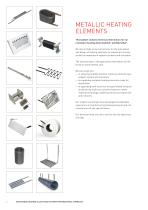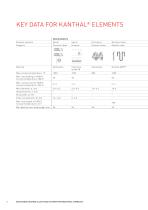 Website:
Kanthal
Website:
Kanthal
Group: SANDVIK
Catalog excerpts

RESISTANCE HEATING ALLOYS AND SYSTEMS FOR INDUSTRIAL FURNACES PRODUCT OVERVIEW
Open the catalog to page 1
RESISTANCE HEATING ALLOYS AND SYSTEMS FOR INDUSTRIAL FURNACES
Open the catalog to page 2
CONTENT METALLIC HEATING ELEMENTS FROM SANDVIK4 KANTHAL OR NIKROTHAL?5 KANTHAL APM™ HEATING MATERIAL6 The great advantages of Kanthal APM are PHYSICAL AND MECHANICAL PROPERTIES7 ELEMENT SURFACE LOAD8 OPERATING LIFE AND MAXIMUM PERMISSIBLE TEMPERATURE 10 Use Kanthal alloys Avoid temperature fluctuations Choose thick element material Adjust the element temperature to the furnace atmosphere Avoid corrosion from solid substances, fluids and gases KEY DATA FOR KANTHAL® ELEMENTS 12 TUBOTHAL® – THE MOST POWERFUL METALLIC ELEMENT SYSTEM 14 High power output Power supply TABLES, STANDARD...
Open the catalog to page 3
METALLIC HEATING ELEMENTS This booklet contains technical information for our resistance heating alloys Kanthal® and Nikrothal®. We also include some instructions for the calculation and design of heating elements for industrial furnaces as well as examples of support systems and insulation. The latest product- and application information will be found on www.kanthal.com. We can assist you: — n choosing suitable element material, element type, i support system and insulation — y supplying complete heating elements ready for b installation — n upgrading both electrical and gas heated...
Open the catalog to page 4
KANTHAL OR NIKROTHAL? There are two main types of electric resistance alloys. Nickel-chromium (e.g. 80 Ni, 20 Cr) called Nikrothal was developed around the beginning of the 20th century and was soon used as heating element material in industrial furnaces as well as in electric household appliances. In the thirties AB Kanthal introduced a new resistance heating alloy (called Kanthal) based on ironchromium-aluminium with a longer life and a higher maximum operating temperature than nickelchromium. Kanthal manufactures both types of alloys under the names Nikrothal (nickel-chromium) and...
Open the catalog to page 5
KANTHAL APM™ HEATING MATERIAL Kanthal APM™ is a resistance material which can be used to improve the performance at high temperatures, where conventional metallic elements are getting problems like bunching, creeping, oxide spallation and to open up new applications where metallic elements are not used today. CREEP RUPTURE STRENGTH FOR INDUSTRIAL WIRE 4 MM TIME, H IMPROVED HOT STRENGTH, GIVING: — uch better form stability of the heating element m — ess need for element support l — ow resistance change (ageing) l — longer element life EXCELLENT OXIDE, GIVING: — ood protection in most...
Open the catalog to page 6
PHYSICAL AND MECHANICAL PROPERTIES Kanthal® and Nikrothal® alloys are generally available in wire, ribbon or strip form. Physical and mechanical properties of the alloys are listed in the table below. C t factor see page 17 and following. KANTHAL AND NIKROTHAL BASIC DATA KANTHAL Max continuous operating temp. °C Nominal composition, % Specific heat capacity at 20°C, KJ kg-1 K-1 Mechanical properties (approx.)* Creep strength at 800°C at 1000°C Magnetic properties Emissivity, fully oxidized condition magnetic (curie point 600°C) 0.70 * The values given apply for wire sizes o
Open the catalog to page 7
ELEMENT SURFACE LOAD Since Kanthal® alloys can be operated at higher temperatures than Nikrothal® alloys, a higher surface load can be accepted without jeopardizing element life. Element design is also of great importance. The more freely radiating the element form, the higher the maximum surface load can be. Therefore the ROB (rod over bend) type element (corrugated heavy wire, mounted on the surface), can be loaded the highest, followed by the corrugated strip element. Coil elements on ceramic tubes can be loaded higher than coil elements in grooves. The values in the diagrams on page 9...
Open the catalog to page 8
Note: The diagrams are valid for thyristor control. For on-off control lower surface loads should be chosen (about - 20%). MAXIMUM RECOMMENDED SURFACE LOADS FOR NIKROTHAL ALLOYS IN INDUSTRIAL FURNACES Surface load, W/cm2 12 F reely radiating corrugated wire elements F reely radiating corrugated strip elements S piral elements on ceramic tubes H eating elements in grooves RESISTANCE HEATING ALLO
Open the catalog to page 9
OPERATING LIFE AND MAXIMUM PERMISSIBLE TEMPERATURE When heated, resistance heating alloys form an oxide layer on their surface, which prevents further oxidation of the material. To accomplish this function the oxide layer must be dense and resist the diffusion of gases. It must also be thin and adhere to the metal under temperature fluctuations. In these respects the aluminium oxide formed on Kanthal® alloys is even better than the oxide formed on Nikrothal® alloys, which contributes to the much longer operating life of Kanthal heating elements. The diagram below shows the comparative...
Open the catalog to page 10
CHOOSE THICK ELEMENT MATERIAL The material thickness has a direct relationship to the element life, in that, as the wire diameter is increased, more alloying element is available per surface unit to form a new oxide. Thus, at given temperature, thicker wires will give a longer life than thinner wires. Accordingly, for strip elements, increased thickness gives a longer life. As a general rule, we recommend minimum 3 mm wire diameter and 2 mm strip thickness. ADJUST THE ELEMENT TEMPERATURE TO THE FURNACE ATMOSPHERE The table shows some common furnace atmospheres and their influence on the...
Open the catalog to page 11
KEY DATA FOR KANTHAL® ELEMENTS WIRE ELEMENTS Element systems Ceramic tubes Ceramic tubes Metallic rods Kanthal APM™ Max. wall loading at 1000°C furnace temperature, kW/m2 Max. surface load at 1000°C furnace temperature, W/cm2 Outer coil diameter, D, mm Max. loop length at 1000°C furnace temperature, mm Min. pitch at max. loop length, mm
Open the catalog to page 12
STRIP ELEMENTS Corrugated Metallic staples Ceramic tubes U-shaped Kanthal® nails Ceramic cup locks Ceramic bushes Ceramic tubes
Open the catalog to page 13
TUBOTHAL® – THE MOST POWERFUL METALLIC ELEMENT SYSTEM Tubothal® is an ideal electric element used in combination with powder metallurgy tubes because of its great advantages, such as – very high power – long life – low weight – easy to design to existing power controls and supply. Combined with Kanthal APM™ tubes, a “maintenance free system” is obtained with high reliability and with no need to remove elements, clean or rotate tubes, if correctly designed. The variety of applications where the Tubothal system can be used is vast. The main areas of use are in heat treatment, aluminium and...
Open the catalog to page 14All Kanthal catalogs and technical brochures
-
HIGH POWER HEATING ELEMENTS
8 Pages
-
KANTHAL® AM100
3 Pages
-
Thermocouple wire and strip
32 Pages
-
Resistance heating strip
100 Pages
-
double layer capacitors
40 Pages
-
Axial-leaded resistors
4 Pages
-
Furnace rollers
2 Pages
-
Furnace tubes
36 Pages
-
Diffusion cassettes
44 Pages
-
Air heating cassettes
8 Pages
-
heating elements
147 Pages

























